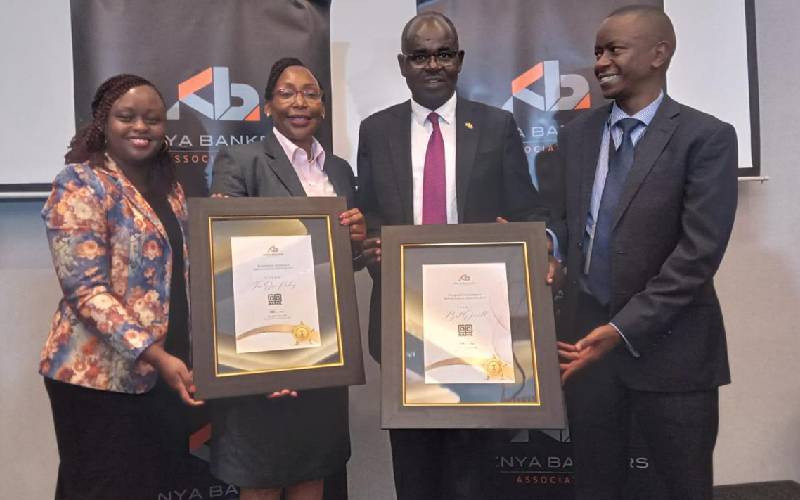They say that if you can’t beat them join them. So, after a decade of soaking up blows from mobile money transfer services, traditional banks have resolved to do the inevitable: move most of their services to mobile phones.
The next battleground in Kenya’s financial sector will be the mobile phone which banks are slowly but surely turning into banking platforms.
Lenders have been sending employees home even as they channel most services to mobile phones and agencies. It has been a desperate move to survive the onslaught from mobile money transfer services—particularly Safaricom’s M-Pesa.
There is no doubt that banks’ fortunes have been dwindling. Stiff competition from SACCOs and micro finance institutions has eaten into their profit margins. And the passage of the law that placed a ceiling on interest rates they charge on loans only served to add salt to injury. The legislation also placed a floor on the interests they give depositors for their savings. Interest income has been the biggest contributor to the lenders’ revenue.
With their options for making money squeezed, banks have had no choice but to plunge headlong into the arena of mobile money transfer services. Thus, about two weeks ago banks launched inter-bank switch to enable customers to transfer money from one bank account to another in real time.
Known as PesaLink platform, it is seen by the banks as the perfect antidote for their eternal tormentor, M-Pesa—though they insist the platform is not in competition with others. So far, 12 commercial banks have signed in to it with the other 30 expected to jump onto the bandwagon by end of this month.
Profit-deficient
When launching the service, Kenya Bankers Association (KBA) CEO Habil Olaka said the platform will enable customers to pay for almost any service without the hustle of going through “intermediaries.”
This might be seen as a warning shot to M-Pesa and other mobile money transfer services like Airtel Money and Orange Money which have minted billions of shillings simply by acting as conveyor belts for money leaving bank vaults to be spent by consumers in many ways.
Before the advent of mobile money transfer services, banking halls would be jam-packed with long queues of people paying for various bills, including rent, school fees, water, telephone or electricity. For those who wanted to shop without cash, the only available options were credit and debit cards. All these services would attract fees that would in turn swell banks’ profits.
Today, even as the volume and variety of such transactions have increased, banks have still missed out on this cash-party with Kenyans opting to do most of their transactions either using cash (over 92 per cent of transactions in the country are still cash based, according to the latest reports) or their handsets. This has left bankers green with envy.
Many Kenyans pay utility bills like water and power among others using M-Pesa.
The story is the same with cashless shopping. When they are buying goods from a supermarket in one of the upmarket malls or a cereals store in their neighbourhood, Kenyans are more likely to use M-Pesa than their debit or credit card.
For banks the Lipa na M-Pesa service, whose popularity has thrust the country on the path to a cashless economy, has left them brooding. Although cash is still king in Kenya, Lipa na M-Pesa— rather than credit and debit cards— is gradually reducing the notes and coins in circulation.
Banks have realised that perhaps Kenya might follow a different path to become a cashless economy. Unlike most economies where credit cards have been at the heart of the cashless transactions, in Kenya it has started with mobile money transfer services.
Stay informed. Subscribe to our newsletter
According to data from the 2016 FinAccess Household Survey, for most Kenyans, mobile phone is their preferred bank. The survey found that six out of 10 Kenyans in 2016 kept their money on mobile phones platforms. Over two-thirds of Kenyans kept their money on these mobile platforms for more than a week, essentially using these platforms as one would a bank account.
Twenty per cent of the Kenyans interviewed used mobile financial services accounts to pay for goods, services and bills. Another 23.4 per cent used it for payment related to business and agriculture, the mainstay of Kenya’s economy.
Thirty two per cent deposited their money on their mobile financial services account when travelling, up from 23 per cent in 2013.
But with the launch of PesaLink banks will be hoping to also benefit from this windfall. This they intend to achieve by first and quickly starting the divorce proceedings against M-Pesa and other mobile money transfer services, freeing themselves from what they believe is an asymmetrical relationship in which the latter has assiduously exploited.
For several years, banks have grudgingly cooperated with M-Pesa, allowing M-Pesa subscribers to seamlessly move money from their bank accounts into M-Pesa wallets and vice-versa. After deducting their withdrawal fees, banks have been left as spectators in the subsequent transactions in which M-pesa has amassed billions of shillings in revenue.
Over time, the relationship between M-Pesa and banks has since deepened with the two partnering to extend traditional banking services—savings and loans — to subscribers of mobile financial services.
Commercial Bank of Africa was the first to break ground with M-Shwari. KCB followed with KCB M-Pesa. Equity Bank chose a different path, working with Airtel to establish its own mobile virtual network operator (MVNO) Equitel, after a short-lived dalliance with Safaricom.
On Thursday, when KCB released their financial results for the year ending December 2016, it became evident that mobile loans had played a critical role in propelling the country’s biggest lender by asset base to profitability. 90 per cent of the loans processed were mobile phones and 53 per cent of customer interaction was via mobile handsets.
Real time settlement
When M-Pesa was launched back in 2007, banks did not see it as a threat. After the platform gained considerable ground in the market, traditional banks got jittery. They quickly sought to tame M-Pesa by seeking regulations from the government. Unfortunately, they never succeeded.
“M-Pesa was not seen as a threat to banks till they got connected to Automated Teller Machines (ATM), and the convergence with banking increased. Banks must be wondering why someone can offer banking or quasi-banking services without a license,” said University of Nairobi lecturer Dr XN Iraki in 2008.
And according to KBA chief executive officer, PesaLink seeks to do just that. “It (PesaLink) enables pushing money from a bank account to another bank account in real time and this can now be done across five channels of which mobile is one. The others are internet, ATM, OTC, Agents,” said Olaka.
Mr Olaka explained that this service of real time settlement has not always been there. “RTGS (Real Time Gross Settlement) is quasi-real time and you still need to walk to the bank and not with the convenience that KITS now provides. There is a huge segment of Sh70,000 to to Sh999,999 that the current mobile money service providers are not serving, which KITS is targeting,” he added.
 The Standard Group Plc is a
multi-media organization with investments in media platforms spanning newspaper
print operations, television, radio broadcasting, digital and online services. The
Standard Group is recognized as a leading multi-media house in Kenya with a key
influence in matters of national and international interest.
The Standard Group Plc is a
multi-media organization with investments in media platforms spanning newspaper
print operations, television, radio broadcasting, digital and online services. The
Standard Group is recognized as a leading multi-media house in Kenya with a key
influence in matters of national and international interest.
 The Standard Group Plc is a
multi-media organization with investments in media platforms spanning newspaper
print operations, television, radio broadcasting, digital and online services. The
Standard Group is recognized as a leading multi-media house in Kenya with a key
influence in matters of national and international interest.
The Standard Group Plc is a
multi-media organization with investments in media platforms spanning newspaper
print operations, television, radio broadcasting, digital and online services. The
Standard Group is recognized as a leading multi-media house in Kenya with a key
influence in matters of national and international interest.







